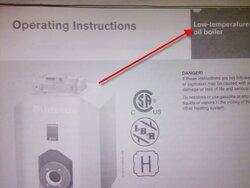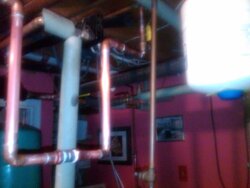The main part of this is about my oil boiler but it is wood related as the end result is hooking up my Tarm to my current system.
I have a Taco JVC-406, a Riello F-3 40 burner installed on a BIASI boiler. The way it's currently wired is in what Riello calls the 120V setup. Pretty much the burner and the zone controller operate independent of each other as far a firing goes. The burner is kicked on by an aquastata that mounted on the boiler and the zone controller just manages the zone valves and kick on the circulator pump when there's a call for heat.
I'm not really sure how common this setup is, it seem like I read a lot more about folks using the 24V setup, and the main end switch (TT) to control the boiler.
I was talking to a friend who's family is in the heating business and while he went in another direction he's been around it all his life. He wasn't familiar with my configuration and thought it might not be the most efficient since even when there's no call for heat the boiler is always going to be kept hot. I suspect this setup is why I get random short fires during the winter (it kicks on when there's no call for heat for less the 30 second then kicks off).
Anyway, I'm not sure if there's a right or a wrong way but what's the thoughts on how my system is setup? If anything, it seems like a very simple way to wire up a boiler.
Ultimately I'm going to need to be able to turn my oil boiler and it's circulator off when my my storage tank is up to temp. The folks that sold me my Tarm sent along a Johnson Controls A419 to do the "switching" but it's a 24V version so that's not going to work for me at the moment. I'm also going to have to use a relay since I'm really turning off two systems (the burner and the pump), just looking around it sounds like a Functional Devices RIB2401D would do the trick.
Sorry for this being so long,
K
I have a Taco JVC-406, a Riello F-3 40 burner installed on a BIASI boiler. The way it's currently wired is in what Riello calls the 120V setup. Pretty much the burner and the zone controller operate independent of each other as far a firing goes. The burner is kicked on by an aquastata that mounted on the boiler and the zone controller just manages the zone valves and kick on the circulator pump when there's a call for heat.
I'm not really sure how common this setup is, it seem like I read a lot more about folks using the 24V setup, and the main end switch (TT) to control the boiler.
I was talking to a friend who's family is in the heating business and while he went in another direction he's been around it all his life. He wasn't familiar with my configuration and thought it might not be the most efficient since even when there's no call for heat the boiler is always going to be kept hot. I suspect this setup is why I get random short fires during the winter (it kicks on when there's no call for heat for less the 30 second then kicks off).
Anyway, I'm not sure if there's a right or a wrong way but what's the thoughts on how my system is setup? If anything, it seems like a very simple way to wire up a boiler.
Ultimately I'm going to need to be able to turn my oil boiler and it's circulator off when my my storage tank is up to temp. The folks that sold me my Tarm sent along a Johnson Controls A419 to do the "switching" but it's a 24V version so that's not going to work for me at the moment. I'm also going to have to use a relay since I'm really turning off two systems (the burner and the pump), just looking around it sounds like a Functional Devices RIB2401D would do the trick.
Sorry for this being so long,
K



